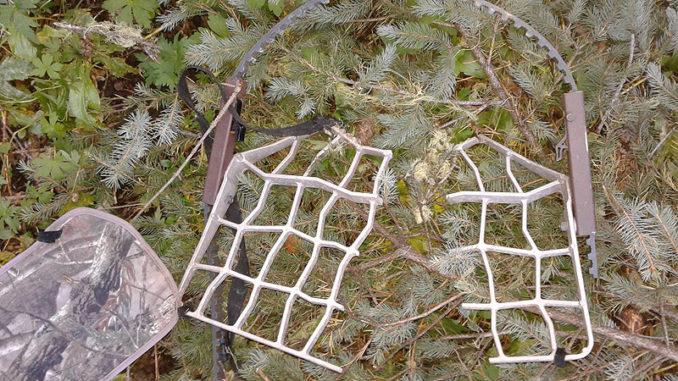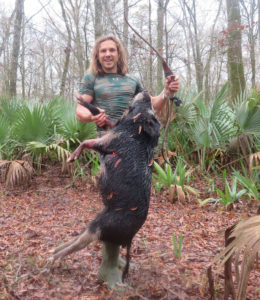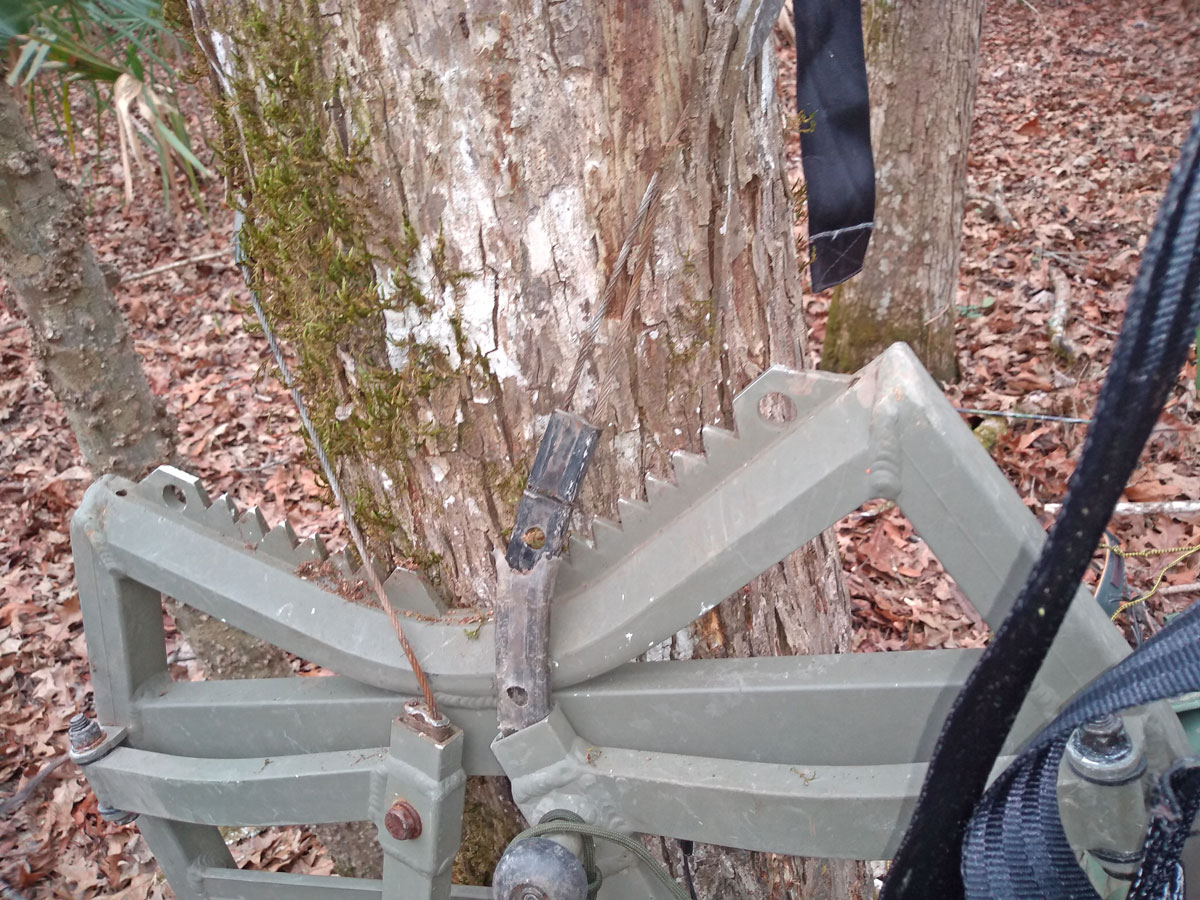
Things you’d never expect can break, and having proper safety equipment can prevent falls and serious injuries
Wearing a safety harness has saved me from tree-stand accidents several times. These incidents are rare, but when making hunts every weekend during a long archery season, unforeseen events are eventually bound to happen.
This year, on my week-long hunting vacation, I had to slide down a tree like a bear not once, but twice, from scary situations where my climbers failed.
Starting out
Growing up, I was fortunate not to find out the hard way about harnesses. I had to learn how to deer hunt on my own, without guidance. I was given an old climber from someone’s attic and set off into the woods alone to down a deer.
It wasn’t long before I found out that climbing stands could be very dangerous. On one of the first times I used that decades-old, smooth, V-style metal climber, it nearly slid all the way down a tree with me in it. Not having a clue what a safety harness was, I remember lassoing my boat’s anchor rope around my torso and bungee strapping that climber to the tree for the next hunt, hoping to avoid another roller-coaster ride experience.
Soon after, I bought my first tree climber and learned how to use the harness that came with the purchase.
Straps vs. ropes
I’m constantly on the move every week on various tracts of land, so I use a basic, full-body, lightweight strap harness. I attach a wide strap to the tree that I slide up and down as I climb. However, this is a slower process to keep lifting and adjusting the strap, and I’ve been busted by several deer that came through while making these lengthy ascents.
For a faster solution, when I have trees that I climb often or when setting up a lock-on where allowed on public lands, I set a safety rope high in the tree. I use my regular tree strap with the harness to get up for the initial setting of the static line above my stand. Then, I use the loop from a prusik knot to attach my harness to a carabiner for fast climbing on future hunts. This knot slides up and down the static rope, but it clinches tight when pressure is pulled from the loop. I tape the carabiner to avoid any metal clanking noises.
With a static rope, I can safely climb a tree in a handful of seconds. Searching the internet for “tree stand safety line” will bring up many pre-made options from which to choose. They can also be homemade for a cheaper solution.
 Metal stands can split
Metal stands can split
The scariest moment I experienced happened when I was hunting in Colorado years ago. I climbed a tree more than 6 miles deep from the trail head where I was dropped off, alone, by my wife. As I got to the desired height in the dark, more than 20 feet up for a morning elk hunt, I put all my weight on the tiny Lone Wolf Hand Climber top piece to get it securely dug into the tree’s bark. I never expected what happened next.
The metal top piece cracked completely in half. The startling jerk left me dangling from my harness. I got all banged up against some of the sharp stubs on this dead fir tree, but I was able to crawl safely down the tree. It was one scary morning, but at least I didn’t get injured way up in the mountains.
The Lone Wolf customer support sent me a brand new Hand Climber top piece as a replacement, which I’ve still been using to this day. Those micro-tops are the lightest, quietest and smallest profile, which makes a great solution to accompany any climber bottom for the standing position I need to use my power recurve bows.
Climbing with one half
I didn’t have any more tree stand issues until this winter. One morning before daylight, I set up in a hard-barked tree that I had climbed many times before, 12 yards from a commonly used community scrape. This tree had a big branch about 17 feet high, so I rehooked my climber top and safety harness strap over the branch. When trying to get ultra-close, within 15 yards of deer for close-range weapons, finding the easiest climbable tree isn’t always an option, and cutting branches isn’t legal.
After setting up my bag and action cameras, I realized I needed to reposition the bottom piece of the Summit stand to a better angle, just under the branch. When I shifted my feet back from resetting it, the stationary platform slipped loose. I tied the pieces together a bit too far, but I thought, “No big deal,” since my paracord was holding the bottom a few feet down. However, as I got on my fingertips stretching down from the hand climber in the pull-up position to reach with my boots, the knot I tied in the dark with cold fingers suddenly sprung loose. The bottom piece tumbled down to the base.
I had to remove the harness’s strap with one arm while bear-hugging the tree, since it couldn’t slide down with the branch. Lowering myself down with arms and legs wrapped around this smaller tree wasn’t difficult; it was the climbing back up to my gear with only the bottom piece to use. It took all my energy to hug the tree and lift the bottom with such a small angle for each tiny 3-inch lift.
Fully exhausted, I was able to get safely set up in the tree for the hunt. A nice buck had passed in front my camera 30 minutes before legal hunting hours. If he had stayed nearby, all the metal clanking definitely scared him off.
The snapped cable
Later in the week, I took one of my older climber bottoms from an API stand with my Lone Wolf top to hunt a new spot. I got set up 20 feet up and was upset that the bottom was squeaking when I moved. Still, I thought “At least I’ll be above the deer.” Well, I wasn’t high for long.
As soon as I leaned over to pull up my bag and recurve, the squeak turned into a snap. The stand flattened against the tree, sending me falling.
Luckily, I was facing the tree and was able to grab the top piece, but that micro hand climber didn’t have any bars to grab, and it cut my wrist until my fingertips found an area to clinch tightly. I was bleeding, with banged-up obliques, but I was holding onto the tree with my other arm while allowing my harness to take some of the weight load as I caught my breath.
The bottom piece was stuck against the tree with its flexible snapped cable cord strung out but not fully detached. I had to keep kicking the stand and cable dozens of times to get it to slide down while using one hand to slide down the harness strap and top piece above me as I hugged my way to the ground. I hiked a mile deeper for another location to keep hunting until dark.
On my 7-day vacation, my Garmin watch logged 141.4 miles while running six half-marathons mid-day between hunts on the nearby high-school track in one of my biggest training weeks for the 2020 Boston Marathon and ultra-marathon season build up. I focused on hiking around 5 miles each morning and each evening for stalks and quick sits in the treetops at my furthest locations. I had no luck with the deer, though I saw some on several hunts, but I was able to harvest a hog, rabbit and a big choupique with my 1960’s vintage recurve. It was one grueling week of quality adventure with a few tree-climber scares that makes my traditional archery pursuits enjoyable, even when the does continuously blew from downwind and the bucks I had rattled and grunted-in ducked under my slow flying feathers — twice.
Double check equipment
Be sure to regularly inspect your equipment. On one hunt, I was taking my lightweight X-stand climber in the woods when I heard rattling and stopped to fix the noise. One of the four fiberglass rods on the climber had cracked in half. After inspecting the stand, I noticed another fiberglass rod had a small crack down the midline.
On some other stands, I’ve had the foot paneling and bolts holding the stand rust and corrode. Even the main steel beams on a couple of climbers have hollowed out with corrosion. I made sure to upgrade to new equipment and trashed those danger traps.

Through the years, I’ve had two T-straps pop, nearly throwing me from a tree each time. Each year, I buy new straps to connect my stands and tree steps.
Years ago, I read that some people were using lower-profiled, rock-climbing harnesses, so I tested one out. I practiced falling from a climber in the yard at eye level. Sure, it saved me from hitting the ground, but it spun me nearly upside down, and wearing running clothes, it left me all bloodied from the impact against the tree. After that experiment, I stuck to using the typical harness that is now required to be worn in some of the national wildlife refuges I hunt. To me, that’s the best rule in the pamphlet.
Preparation
Practicing bear hugging to climb or descend from a tree — or hanging just above the ground in a harness — can prepare you for what it may be like if that happens during a hunt.
In the gym, some of my favorite functional exercises are: muscle ups (pull-ups where you thrust your entire upper body above the bar), one-arm grab pull-ups (using one arm on a bar and grabbing that arm’s wrist with your other hand) and jumping pull-ups (letting go after a thrust up to grab different bars). Also, weighted pull-ups are great as well, since you’re often wearing heavy boots and cold weather gear afield. I usually just get my wife or clients to jump on my back for my sets of these, since stacking plates with a weight belt is a tedious, time-consuming task.
For grip strength, doing pull-ups with one or two fingers and alternating digits, or holding onto a towel laid over the bar will help strengthen one’s grip for when extreme situations occur. Many of these exercises can be done with a pull-up assistance machine or from a lower bar using some leg assistance until full hanging versions can be mastered. Trips to rock-climbing walls are amazing workouts as well.
By always wearing a safety harness in elevated stands, checking equipment and exercising many accidents can be prevented and a lifetime of hunting can be enjoyed!


